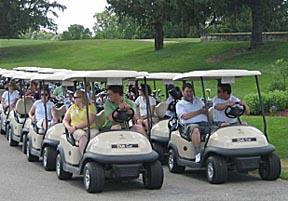A nearly 6 percent increase in rounds played in 2012 is not quite a sign that golf is out of the economic woods, but given the industry's wave of uncertainty the past five years, the news of increased demand certainly is cause for some tempered optimism.
According to Golf Datatech's Monthly Rounds Played Report for December, there was a 5.7 percent increase in year-over-year rounds played in 2012. That statistic is derived from a monthly self-reported survey of 3,285 private clubs and daily fee facilities nationwide.
 While Golf Datatech and the National Golf Foundation use many of the same statistics in calculating the health of the industry, NGF's industry report is not expected until March. However, Datatech's projections would mean there were almost 490 million rounds played last year, bringing participation back to 2008 levels.
While Golf Datatech and the National Golf Foundation use many of the same statistics in calculating the health of the industry, NGF's industry report is not expected until March. However, Datatech's projections would mean there were almost 490 million rounds played last year, bringing participation back to 2008 levels.While demand finally is perking up, NGF's report will all but confirm that the contraction of supply has run on for a seventh straight year.
In their annual State of the Golf Industry report given last month at the PGA Merchandise Show, industry analyst Jim Koppenhaver and Stuart Lindsay estimate that 13.5 new 18-hole equivalents were built in 2012, while 154.5 closed their doors, meaning a projected net loss of 141 18-hole equivalents.
If those numbers hold true it would mean a net loss of about 516 18-hole equivalents since 2006,when the trend of negative growth began. That number is one-half to one-third of the number of golf facilities that industry analysts say must go away before supply-demand equilibrium is achieved.
Koppenhaver says the game faces three challenges to remain a vibrant industry: how to attract women, minorities, juniors and those aged 25-44; how to retain golfers in the game; and how to convince everyone who is not a retiree to play more than just a couple of rounds per year (2.5 million golfers play just one round per year).
Much of the increase in demand could be attributed to the mild winter that dominated much of the country in 2011-12. Koppenhaver tracks what he calls Golf Playable Hours, essentially an inventory of all the daylight hours in which one could play golf factored against climatic influences, such as wind, rain, snow and severe cold, in 45 geographic regions throughout the country. There was a 7.9 percent increase in golf playable hours in 2012 compared with 2011, with 36 of 45 geographic regions showing gains throughout the year. Eight other regions were neutral and only one, Hawaii, showed a reduction in golf playable hours. However, according to Koppenhaver and Lindsay, if every golfer played just one additional round per year it would result in a 5 percent increase in rounds played.
One troubling statistic is that although there was an increase in rounds played in 2012, the industry continues to lose golfers. NGF predicts that about 1 percent of golfers left the game in 2012, but Koppenhaver paints a different picture, projecting that the game shed 2 million players last year a loss of 7 percent. And the population of golfers is becoming older. Men over age 50 constitute 60 percent of all rounds played, and those in the 25-44 age group, once one of the industry's strengths, are leaving the game at an alarming rate.
According to Lindsay of Edgehill Golf Advisors, 45 percent of all golfers fell into that 25-44 age group in 1992. By 2001, that number had fallen to 41 percent and today it is down to just 31 percent. In 2001, there were 11 million golfers in that age group. Today, that number is trending at 6.4 million.
Lindsay noted that many people were introduced to the game as caddies, but that the lack of demand for that service has eliminated exposure to that age group.
Equally disturbing is that play among blacks and Hispanics dropped by 67 percent last year.
Retailers, however, hardly are noticing golfers leaving the game. In fact, according to Koppenhaver, retail sales of equipment have returned to 2009 levels as consumers continue to take advantage of the technological advances of new balls and sticks.

